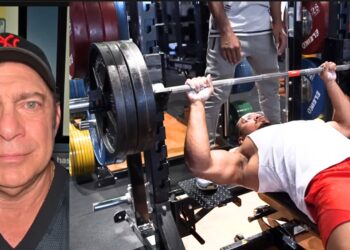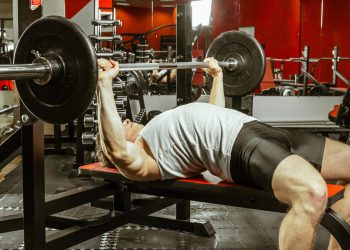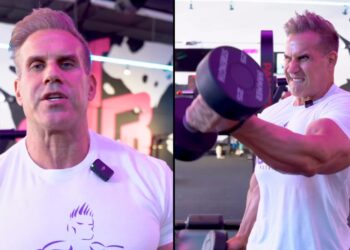If you’ve ever had a chat with a fellow gym-goer about your workouts, invariably, the discussion will turn to the bench press. Why? Because it’s probably the most popular upper body exercise on the planet. Even non-lifters want to know how much you can bench press!
Most of the time, people are talking about the barbell bench press. After all, it’s a classic chest exercise, and it’s also the second lift contested in the sport of powerlifting.
However, despite its popularity, the barbell bench press is not without disadvantages. Lifting a bar with both hands means it’s all too easy to press more with one arm than the other, and a failed rep could leave you badly injured.
Also, bench pressing with a bar means you are limited to how far you can lower the weights. If you have short arms, you won’t get much of a stretch in your chest, and that can limit muscle growth.
None of this means the barbell bench press is a bad exercise, but doing bench press with dumbbells gets around all of these drawbacks. In addition, adding dumbbell bench presses to your workouts will increase exercise variety. Studies tell us that variety is just as important as, sets, reps, and weight for building muscle and strength (1).
In this Dumbbell Bench Press Guide we will discuss:
Level Up Your Fitness: Join our 💪 strong community in Fitness Volt Newsletter. Get daily inspiration, expert-backed workouts, nutrition tips, the latest in strength sports, and the support you need to reach your goals. Subscribe for free!
- How to do the dumbbell bench press
- Programming the dumbbell bench press
- Benefits of the dumbbell bench press
- Muscles worked in the dumbbell bench press
- Dumbbell bench press variations
How to do the dumbbell bench press
To get the most from this (or any other) exercise, you must do it properly. Doing the dumbbell bench press with incorrect form will make it less effective and could increase your risk of injury. Always do this exercise properly for the best results.
1– Sit on the end of an exercise bench with a dumbbell in each hand. Rest the weights on their ends on your thighs.
2– Lie back and use your legs to help you lift the weights. Position yourself, so your back is flat on the bench, your arms are bent, and the dumbbells are in front of your shoulders. Your feet should be flat on the floor. Brace your abs and arch your lower back slightly. Think about lifting your chest up toward the ceiling.
3– Press the weights up to arm’s length above your chest. The dumbbells should come together at the top of each rep. Straighten your arms, but don’t lock your elbows. Locking your arms means your joints are supporting the weight rather than your muscles.
4– Bend your arms and lower the weights back down. Lower them as far as your flexibility allows. A good stretch at the bottom of each rep makes this exercise harder and more productive. However, do not bounce out of the bottom of each rep. That’s a recipe for injury.
5– At the of your set, either lower the weights to the floor or, with your arms bent, just sit back up and return to your starting position. Alternatively, if you have spotters nearby, allow them to take the weights from you.
Video guide to dumbbell bench press exercise
Programming the dumbbell bench press
Don’t just grab any old dumbbells and start pressing; make sure your weights and reps match your training goal. Use the following guidelines to help you choose the right rep range and loading parameters:
For strength: 3-5 reps using 85%+ of your one-repetition maximum (1RM). Rest 3-5 minutes between sets.
For hypertrophy (muscle growth): 6-12 reps using 67-85% of your 1RM. Rest 60-90 seconds between sets.
For muscular endurance:13-20+ reps using less than 67% of your 1RM. Rest 30-60 seconds between sets.
Not sure what your 1RM for the dumbbell bench press is? Don’t worry; just make sure the weight you choose fatigues your muscles within the specified repetition range. If you can’t hit the lower number, the weight is too heavy, but if you can do more than the upper number, the weight is too light.
Benefits of the dumbbell bench press
There are lots of reasons the dumbbell bench press is such a good exercise. Here’s a list of the main ones:
Fix left to right strength imbalances: using dumbbells instead of a barbell will reveal and help fix any left to right strength imbalances. Most people are left or right-side dominant, and small strength imbalances are not an issue. However, if those imbalances become too big, they could lead to injury. Using dumbbells instead of a barbell will eliminate this problem.
Easier on your shoulders: As good an exercise as the barbell bench press is, it can be hard on your shoulders. That’s because the bar fixes your hands into a singular position, and you cannot rotate your wrists the way they want to move naturally. Dumbbells allow you to turn your wrists, which takes stress off your shoulders. Each arm is free to follow a different movement path, which also helps take the pressure off the shoulder joint.
Safety when training alone: if you are unable to complete a rep of barbell bench presses, you could find yourself pinned across the chest with a heavyweight. This is a hard position to get out of if you are training on your own. This is less of an issue with dumbbells because, if you get stuck, you can simply drop the weights out to the side.
Train different joint angles with ease: While you can do flat, incline, and decline barbell bench presses, each variation requires a different bench, and not all gyms have them. With dumbbells, all you need is one adjustable bench, and you can do all these exercises in the same spot. Incline dumbbell bench presses emphasize your upper chest while decline bench presses emphasize your lower chest. Flat dumbbell bench presses work your entire chest fairly evenly.

Increased joint stability: You have to work extra hard to control the weights during the dumbbell bench press. This increased need for control leads to more rotator cuff activation and more stable shoulder joints. Increases joint stability can help reduce your risk of injury (2).
Muscles worked in the dumbbell bench press
The dumbbell bench press is a horizontal pressing exercise. That means the arms are pressed outward and perpendicular to your body. The main muscles used in this exercise are:
- Pectoralis major: This muscle group is the reason that most people do this exercise; it gives your pecs a great workout. Your pecs are the muscles on the front of your chest. Their primary function is horizontal flexion and medial rotation of the shoulder joint.
- Anterior deltoids: Working alongside your pecs, the anterior deltoids or front shoulder muscles are also involved in horizontal flexion and medial rotation of the shoulder joint. It’s virtually impossible to work your pecs without your anterior delts.
- Triceps brachii: Located on the back of your upper arm, the triceps are responsible for extending your elbow. The closer your hands are, the more work your triceps have to do. The triceps are especially active at the end of the movement as you lock out your elbows.
- Rotator cuff: This group of small muscles, consisting of the supraspinatus muscle, the infraspinatus muscle, teres minor muscle, and the subscapularis muscle, is responsible for stabilizing your shoulder. They are especially active during dumbbell bench presses as the weight can move in a variety of directions.
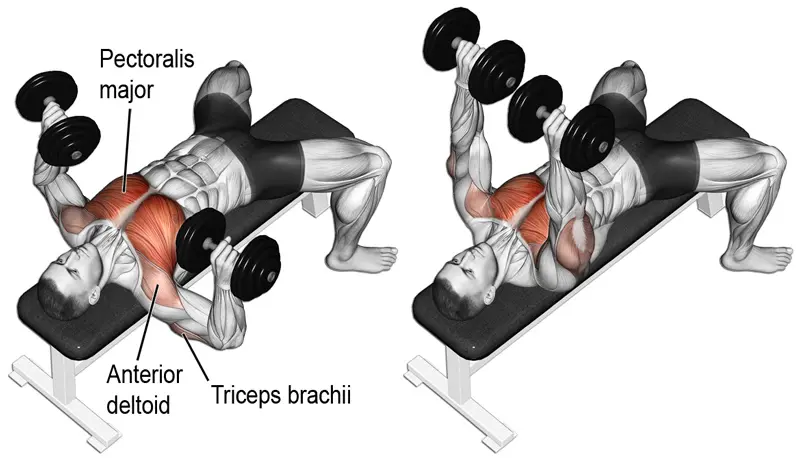
Dumbbell bench press variations
As good as the dumbbell bench press is, if you do it over and over again, your muscles will soon adapt, and it will stop being such a productive exercise. Keep your workouts fresh and exciting with these dumbbell bench press variations.
1- Dumbbell squeeze press
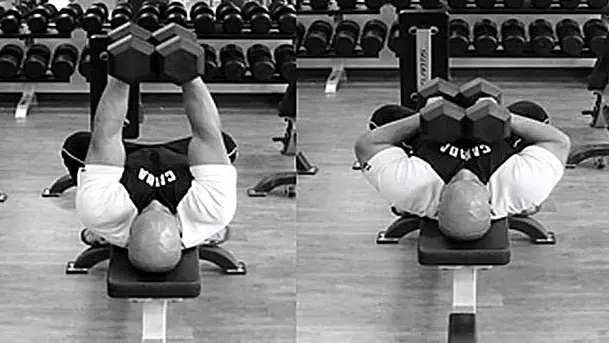
This exercise increases tension in your pecs, especially in the inner region. It’s a very effective chest builder. Also, because you have to push the weights together with all your strength, you won’t need to use as much weight as you would for regular dumbbell bench presses.
How to do it:
1– With a dumbbell in each hand, set up for dumbbell bench presses as usual. Press the weights together as hard as you can and maintain this inward pressure throughout the exercise.
Level Up Your Fitness: Join our 💪 strong community in Fitness Volt Newsletter. Get daily inspiration, expert-backed workouts, nutrition tips, the latest in strength sports, and the support you need to reach your goals. Subscribe for free!
2– Push the weights up to full arm extension and then lower them back to your chest. Keep pushing them together!
This exercise can be done using a flat, incline, or decline bench as preferred.
2- Single-arm dumbbell bench press
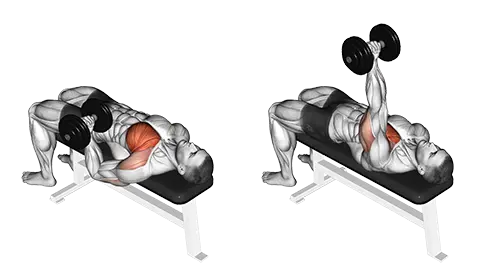
With this variation, you use just one dumbbell and work each arm separately. As well as being a good chest exercise, this version also increases core activation. You’ll need to brace your abs hard to keep your body stable and straight.
How to do it:
1– Grab one dumbbell and set up for the dumbbell bench press as normal. Plant your feet firmly on the floor and brace your abs hard to keep your body tight.
2– Without twisting your shoulders or your hips, press the weight up to full arm extension and then lower it again.
3– Do the same number of reps on each arm.
This exercise can be done using a flat, incline, or decline bench as preferred.
3- Dumbbell floor press
No bench? No problem! Dumbbell bench presses can also be done on the floor. This is a good option if lowering the weights to your shoulders causes shoulder-pain.
How to do it:
1– Lie on the floor with your legs bent, feet flat on the floor. Press your dumbbells up to arms’ length over your chest.
2– Bend your arms and lower the weights until the back of your arms lightly touch the floor. Push the weights back up and repeat.
This exercise can also be done using one dumbbell at a time, or with the dumbbells pressed together, as with the dumbbell squeeze press.
4- Alternating dumbbell bench press
This exercise not only allows you to work one arm at a time, but it will also increase coordination and core strength. It’s a good exercise for muscular endurance and works well when used as part of a fat-burning circuit workout.
How to do it:
1– Set up for the dumbbell bench press as normal. Keep one weight down on your chest and press the other weight up to arms’ length.
2– Next, push the opposite weight up while bending your other arm.
3– Continue alternating arms for the duration of your set.
This exercise can be done using a flat, incline, or decline bench as preferred.
5- Stability ball bench press
The stability ball bench press increases core and rotator cuff activation. You’ll need to concentrate on keeping both the weights and your body stable.
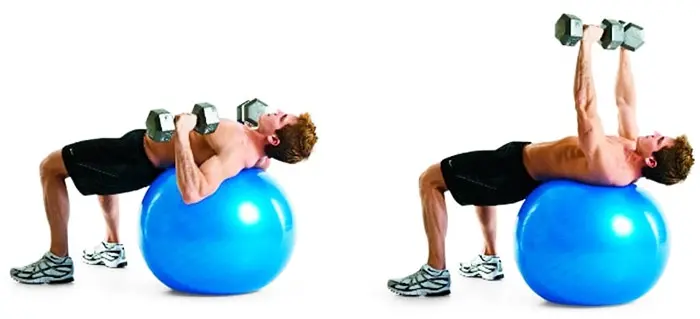
How to do it:
1- Sit on a stability ball with a dumbbell in each hand. Walk your feet forward and lie back until your upper back, shoulders, and head are supported by the ball. Brace your legs and core.
2- Starting with your elbows bent, press the weights up to arms’ length and then lower them again. Make sure you keep your hips and shoulders still and level.
You can also do dumbbell squeeze presses, alternating dumbbell bench presses, and single-arm dumbbell bench presses using a stability ball.
Wrap-up
Whether you are bored of barbell bench presses, or just want to add some variation to your upper body workouts, the dumbbell bench press is a good choice.
Then, once you have mastered it, make sure you try the five variations outlined in this article. With all these exercises available, you have everything you need to build your best chest ever!
References:
- Fonseca, Rodrigo M.; Roschel, Hamilton; Tricoli, Valmor; de Souza, Eduardo O.; Wilson, Jacob M.; Laurentino, Gilberto C.; Aihara, André Y.; de Souza Leão, Alberto R.; Ugrinowitsch, Carlos (2014-11). “Changes in exercises are more effective than in loading schemes to improve muscle strength”. Journal of Strength and Conditioning Research. 28 (11): 3085–3092. doi:10.1519/JSC.0000000000000539. ISSN 1533-4287. PMID 24832974.
- Johnson, Caleb D.; Nijst, Branco K.J.F.; Eagle, Shawn R.; Kessels, Marijn W.M.; Lovalekar, Mita T.; Krajewski, Kellen T.; Flanagan, Shawn D.; Nindl, Bradley C.; Connaboy, Christopher (March 13, 2019). “Evaluation of Shoulder Strength and Kinematics as Risk Factors for Shoulder Injury in United States Special Forces Personnel”. Orthopaedic Journal of Sports Medicine. 7 (3). doi:10.1177/2325967119831272. ISSN 2325-9671. PMC 6416681. PMID 30891463.
Article Updates Timeline:
Our editorial team experts constantly update the articles with new information & research, ensuring you always have access to the latest and most reliable information.
January 4, 2024
Updated By
Tom Miller, CSCS
February 3, 2023
Updated By
Tom Miller, CSCS
Fact Checked By
Dr. Malik
February 6, 2020
Written By
Patrick Dale, PT, ex-Marine
Reviewed By
Editorial Team
Interested in measuring your progress? Check out our strength standards for Bench Press, Dumbbell Floor Press, Floor Press, and more.





